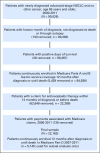Antineoplastic Treatment of Advanced-Stage Non-Small-Cell Lung Cancer: Treatment, Survival, and Spending (2000 to 2011)
- PMID: 28045621
- PMCID: PMC5455316
- DOI: 10.1200/JCO.2016.69.4166
Antineoplastic Treatment of Advanced-Stage Non-Small-Cell Lung Cancer: Treatment, Survival, and Spending (2000 to 2011)
Abstract
Purpose Multiple agents for advanced non-small-cell lung cancer (NSCLC) have been approved in the past decade, but little is known about their use and associated spending and survival. Methods We used SEER-Medicare data for elderly patients with a new diagnosis of advanced-stage NSCLC and were treated with antineoplastic agents between 2000 and 2011 (N = 22,163). We estimated the adjusted percentage of patients who received each agent, days while on treatment, survival, and spending in the 12 months after diagnosis. Results During the 12-year study period, a marked shift in treatment occurred along with a rapid adoption of pemetrexed (39.2%), erlotinib (20.3%), and bevacizumab (18.9%) and a decline in paclitaxel (38.7%), gemcitabine (17.0%), and vinorelbine (5.7%; all P < .05). The average total days on therapy increased by 5 days (from 103 to 108 days). Patients who received bevacizumab, erlotinib, or pemetrexed had the longest treatment durations on average (approximately 146 days v 75 days for those who did not receive these agents). Approximately 44% of patients received antineoplastic agents in the last 30 days of life throughout the study period. Acute inpatient spending declined (from $29,376 to $23,731), whereas outpatient spending increased 23% (from $37,931 to $46,642). Median survival gains of 1.5 months were observed. Conclusion Considerable shifts in the treatment of advanced-stage NSCLC occurred along with modest gains in survival and total Medicare spending. More precise outcome information is needed to inform value-based treatment decisions for advanced-stage NSCLC.
Figures
References
-
- American Cancer Society Key statistics for lung cancer. http://www.cancer.org/cancer/lungcancer-non-smallcell/detailedguide/non-...
-
- National Cancer Institute: SEER stat fact sheets: Lung and bronchus cancer. https://seer.cancer.gov/statfacts/html/lungb.html
-
- Ramsey SD, Howlader N, Etzioni RD, et al. Chemotherapy use, outcomes, and costs for older persons with advanced non-small-cell lung cancer: Evidence from Surveillance, Epidemiology and End Results-Medicare. J Clin Oncol. 2004;22:4971–4978. - PubMed
-
- Rocha Lima CM, Herndon JE, II, Kosty M, et al. Therapy choices among older patients with lung carcinoma: An evaluation of two trials of the Cancer and Leukemia Group B. Cancer. 2002;94:181–187. - PubMed
MeSH terms
Substances
LinkOut - more resources
Full Text Sources
Other Literature Sources
Medical
Miscellaneous


